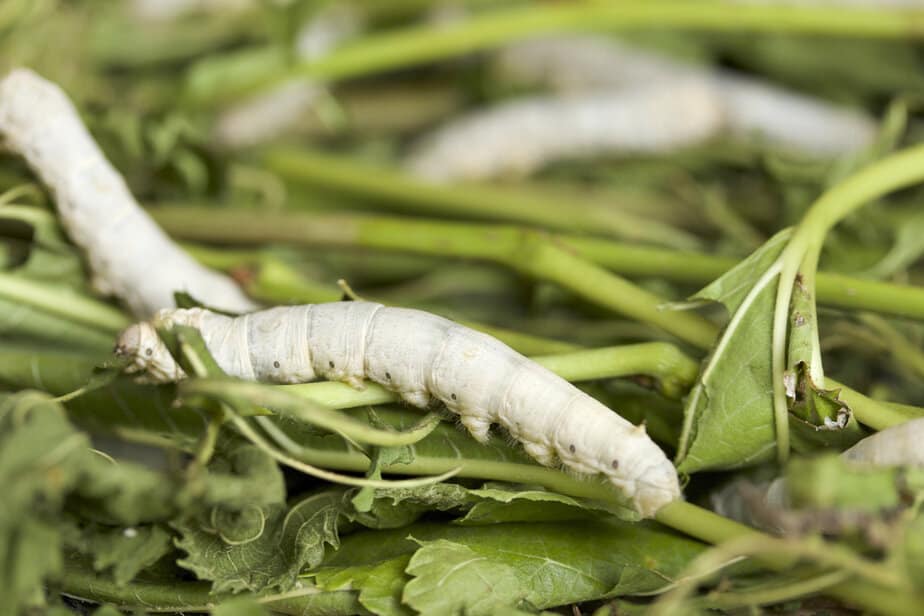If there’s one thing you should know about leopard geckos, it’s that they love eating worms. But can these reptiles eat silkworms?
Leopard geckos can eat silkworms. Silkworms contain important nutrients for a growing leopard gecko. Silkworms contain water, protein, fat, and calcium. Also, they are tasty and a great option for picky eaters.

What are silkworms?
Silkworms are the larval stage of Mulberry silkmoths. They are known for their ability to create silk and are usually cultured on a large scale for this purpose.
Generally, silkworms are odorless, quiet, and slow. Native to Northern China, these worms predominantly eat mulberry leaves.
Why should you feed your leopard gecko silkworms?
The major benefits of offering your leopard gecko silkworms are:
They are rich in moisture
If silkworms have one thing going for them, it’s their high moisture content of 82.7%.
This makes them excellent leopard gecko food, particularly because these reptiles get most of their water from the insects they consume.
So if your leopard gecko rarely drinks the water you leave out for them, adding some silkworms to their diet would do them good.
You can even offer these worms as a way to hydrate a dehydrated leopard gecko quickly.
After all, dehydration can come with severe consequences for leopard geckos. It can cause problems with their digestion, vitamin absorption, and even physiological functions.
They have calcium
One kilogram of silkworms has approximately 177 mg of calcium – this is more than what butterworms have and is almost the same amount present in superworms.
However, it is way less than the amount of calcium present in black soldier fly larvae. As such, you can’t depend on silkworms to satisfy all of your leopard gecko’s calcium needs, especially since it’s difficult to even dust these worms.
Since their exteriors are smooth, they can’t retain much calcium or multivitamin powder. Ultimately, you’re better off dusting the other insects that you’re planning to feed your leopard gecko and just offering the silkworms as they are.
They have a good amount of protein
9.3% of a silkworm is protein – a reasonable amount for leopard geckos.
That’s why silkworms are a good food choice for growing, gravid, and sick leopard geckos.
After all, the protein in them can help your reptile’s body repair its cells, build muscles, produce antibodies, and even create enzymes.
They have little fat
While fat does help some of your leopard gecko’s body processes, such as reproduction and inflammation, overconsumption can quickly lead to obesity.
That’s why the fact that silkworms only have 1.1% of fat isn’t a bad thing. It simply means that you can offer them more frequently to your leopard gecko than you would fatty alternatives like butter worms.
They contain some vitamins
Silkworms contain Vitamin A, B5, B1, and B2.
They are tasty and easy to eat
Since silkworms are tasty, even picky leopard geckos will eat them. Also, they are soft, making them easy for your leopard gecko to swallow and digest.
You don’t need to gut-load silkworms
Because silkworms primarily eat mulberry leaves, there’s usually no need to gut-load them.
Keeping and serving them requires little energy
Under ideal settings, silkworms grow slowly and can be stored for a while without any issues. Also, since they are odorless and quiet, keeping them doesn’t disrupt your daily life.
Silkworms move slowly, so you don’t have to worry about them making a run for it when you’re offering them to your leopard gecko.
What challenges come with feeding your leopard gecko silkworms?
The major challenges you should be prepared to face when you start feeding your leopard gecko silkworms are:
Supply shortage
Sometimes, silkworms aren’t readily available – you may even notice that you can only buy them from online stores from time to time.
That’s why some leopard gecko owners opt to buy a bunch of silkworm eggs and then store them in their house until they are larvae ready for consumption.
After all, you can control the temperatures in your home to prolong the life cycles of these worms.
Expensive housing and feeding requirements
Since silkworms need a supply of mulberry leaves and a temperature of around 77 degrees Fahrenheit to thrive, you will need to spend a substantial amount of money to keep them.
And to make things worse, changes in their temperature and housing conditions can easily leave them sick or even dead. Learn how to know if your leopard gecko is dying.
Final thoughts
Generally, silkworms are great for leopard geckos. They are nutritious, tasty, easy to digest, and have no nutritional drawbacks. As long as you ensure that your leopard gecko also eats other insects, they should be fine.
It just sucks that silkworms are expensive to keep and aren’t readily available. If you’re okay with this, though, go ahead and get them!
